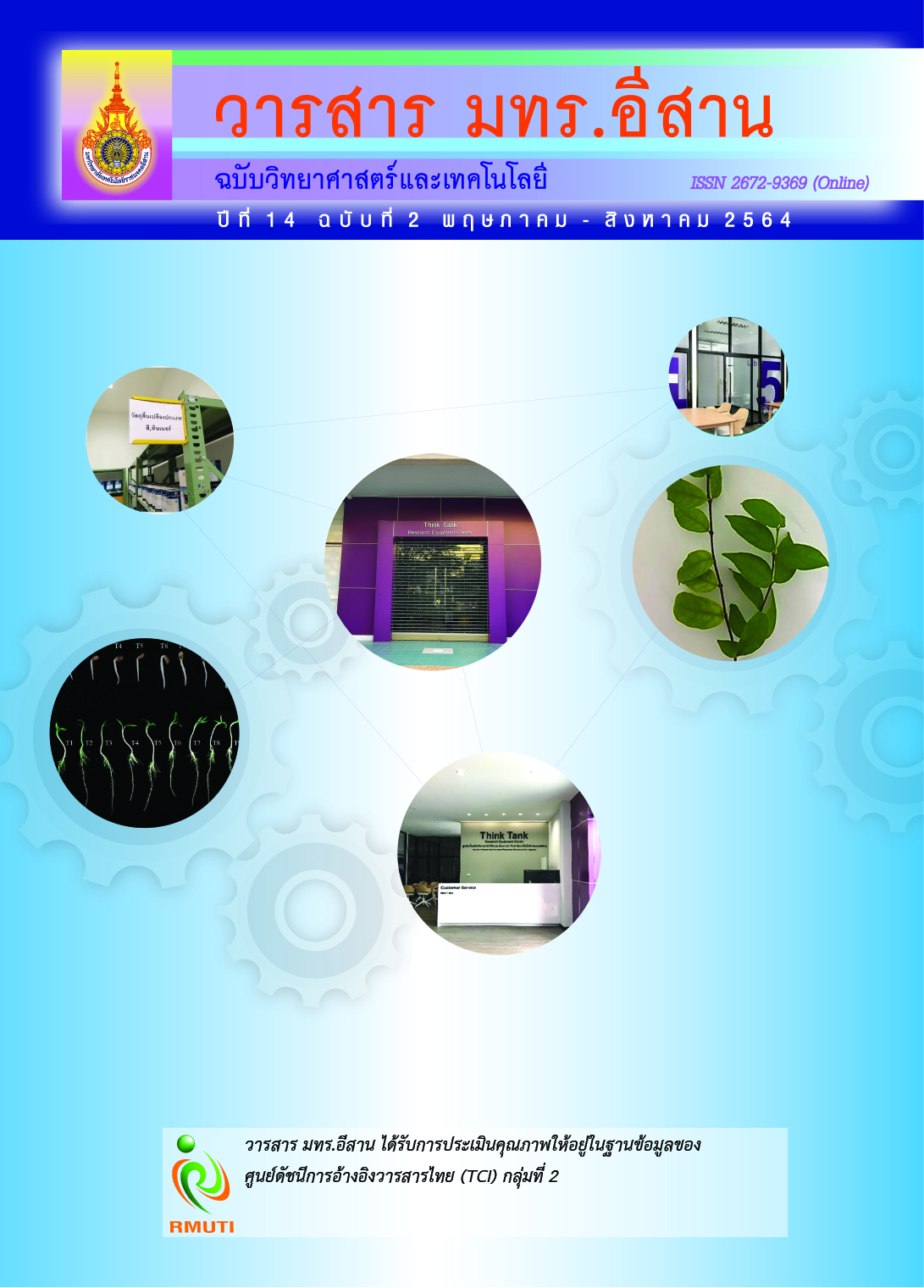Effects of Alkalis on Sedimentation and pH of the Colored Water Extracted from Water Jasmine Leaves
Main Article Content
Abstract
This research aimed to study the effect of alkaline type on the precipitation of color extracted from Water Jasmine leaves by using cold extraction method. The ratio of Water Jasmine leaves: water was 1:5 (weight/volume, w/v), soaked at room temperature for 72 hours. The results were found that the color of extracted solution from Water Jasmine leaves was green-blue color and the pH value was 4.8. The wavelength of maximum absorbance (λmax) was 510 nanometer. The color of The three different kind of alkaline substances: red lime, lime and sodium carbonate were added in the extracted solution at a ratio of alkaline agent: Water jasmine extracted solution was 1:10 (w / v) then stir the solution together with the extracted solution from the Water Jasmine leaves. Leave it at room temperature for 24 hours for the solution to be precipitated. Weigh the resulting sludge and measure the pH value. It was found that different type of alkaline substances had signifi cantly different effect on 0.05. The formation of colored sludge and pH value of solution extracted from the Water Jasmine leaves, characteristic and weight of sludge obtained from different alkaline substances. The sludge of red lime looks like a dark blue mud. Lime sediments are characterized by a bluish sandy texture. The sediment weight was 61.3 and 25.3 grams, and sodium carbonate had no precipitation formed, but the colored solution was darker. The results of the three different kind of alkaline substances on solution extracted from the Water Jasmine leaves were found that the addition of red lime had the highest pH, followed by sodium carbonate and lime with a pH of 11.5, 9.8 and 5.4 respectively.
Article Details
References
Younsook, S., Dong Il ,Y., and Kangwha, K. (2012). Process Balance of Natural Indigo Production Based on Traditional Niram Method. Textile Coloration and Finishing. Vol. 24, Issue 4, pp. 253-259. DOI: 10.5764/TCF.2012.24.4.253
Gokhale, S. B., Tatya, A. U., Bakliwal, S. R., and Fursule, R. A. (2004). Natural Dye Yielding Plants in India. R.C. Patel College of Pharmacy Shirpur, India
Meipan, N. (2015). Silk Dyeing with Natural Dyes from Krachai Dam Rhizome. Master’s Thesis, Kasetsart University
Saithong, A. (2012). Natural Dyed Indigo Silk. KKU Science Journal. Vol. 40, Number 2, pp. 423-435
Yoshiko, I. W., Rice, M. K., and Barton, J. (1999). Shibori: The Inventive Art of Japanese Shaped Resist Dyeing. Tokyo: Kodansha International 277-283
Mongkolrattanasit, R., Klaijoi, C., ChangMuang, S., Sasitorn, N., ManaRungwit, K., Mahain, K., PhaisanTantiwong, N., Roongruangkitkrai, N., Chamnongkan, T., Wong Phakdi W., and Tiyasri S. (2017). New Natural Indigo Dyeing Guide on Silk and Cotton Yarns Commercially. Kor-Hor Company Limited. Bangkok
Puakpong, S. (2018). Natural Dyes Technology. Department of Home Economics. Kasetsart University, Bangkok. (Teaching Document)
Maugare, T., Enaud, E., Sayette, A. D. L., Choisy P., and Legoy, M. D. (2002). Beta-Glucosidase- Catalyzed Hydrolysis of Indican from Leaves of Polygonum tinctorium. Biotechnology Progress. Vol. 18, Issue 5, pp. 1104-1108. DOI: 10.1021/bp025540+
Chantarangsi, K. (2013). Design of Weaving Structure for Hand-Woven Indigo Dye Fabric. Case Study Group of Ban Don Koi Indigo-Dyed Weaving Group Phanna Nikhom District Sakon Nakhon. Province Graduate School. Srinakarinwirot University
Sahakitpichana, P., Chimnoia, N., Srinrocha, C., Ruchirawata, S., and Kanchanapooma, T. (2018). Benzoxazinoid and Indoxyl Glycosides from Wrightia Religiosa. Faculty of Pharmaceutical Sciences, Khon Kaen University. Khon Kaen
Precha, P. (2009). The Study of Natural Indigo Dyeing Processic on Cotton. Bachelor of Science Project in Chhemisty. Nakhon Si Thammarat Rajabhat University


